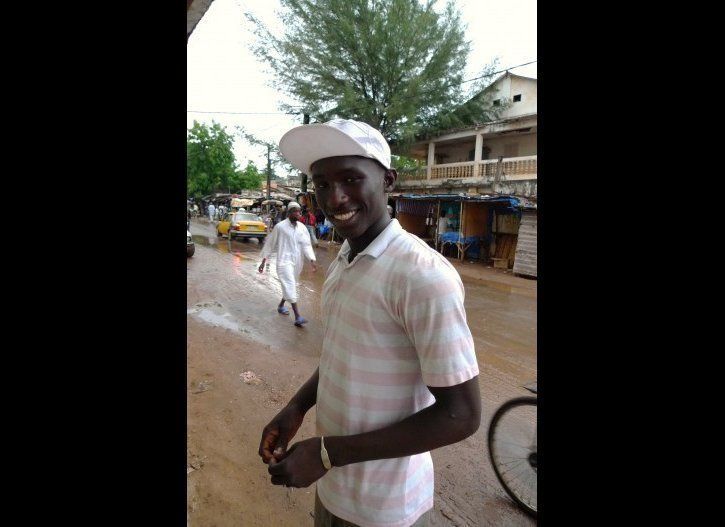My daily romp around the city where I live in Senegal affords me a view of urban fashion trends. I've lived here for two years and speak the local Pulaar in addition to French, but no matter how "integrated" I've become with "the locals," I'm aware that I'll always be a foreigner. Being a constant outsider, while imprisoning at times, allows me some freedoms.
Senegalese people already think I'm wacky, so I waste less time caring about others' opinions of me. I can't always communicate, so I spend more hours just thinking. People stare at me, so I stare at them.
In my de-facto role as an observer, I have become fascinated with the style choices I see on the street. On one end of the spectrum, there are older women, who by loyalty to convention or lack of economic freedom wear head-to-toe complets and matching head scarves. This satisfies a stereotypical vision of traditional West African attire: sculptural head wraps, quirky patterns (Obama's face, a severed finger), and unapologetically loud colors.
On the other end of the spectrum, there are those who are more experimental with their fashion. Men tend to do this more, often because they are granted more social freedom and have more disposable income. They wear bold hats or provocative t-shirts, at times looking silly; at other times, avant-garde. I live for the sight of elderly men ready for Friday mosque, in long robes and Moroccan fez hats, clutching prayer beads and looking utterly conservative, yet who with one touch--classic round sunglasses--are chic. Whether wearing $2 plastic jellies or a woman's velour sweater, it's one's confidence that lends to one's swagger.
For nearly two years, I found myself dying to take portraits of all the stylish people I saw around town. The problem was, taking pictures of strangers in Senegal is a sensitive act; I've been berated in the market for snapping a shot of fish lying on the ground. With time, I gained a better feel for people and learned that photo opportunities come of informal conversations and asking for consent, not of claiming other people's images at the slightest touristic urge.
After I started shooting, a friend pointed me in the direction of the guerilla-style fashion site Accidental Chinese Hipsters. On it, contributors post photos (often taken furtively) of Chinese people wearing outfits that at first glance seem awkward, yet upon further reflection could be construed as hipster. It dawned on me that maybe what transfixed me about Senegalese men's style was a certain fuck-you attitude toward clothing, a can't-put-your-finger-on-it otherness that conveys humor and that people might aptly describe with the overused term, "hipster."
Thus, my fixation on the accidental hipsters of Senegal, the people who wear the detachable hoods of ski jackets as hats and who zero-in on t-shirts with wolf illustrations in the thrift markets. Their look is refreshing because it's not over-calculated--they just like what they like. One of my favorite outfits was a woman's complet with a retro floral design and gold zippers. I couldn't get her picture; she was on the back of a moto, speeding fast ahead.
The fashion I'm witnessing is the result of a shift taking place in Senegalese style. Much of it is due to the global used clothing industry. According to the Office of the U.S. Trade Representative, used clothing was the 5th largest import to Senegal from the U.S., clocking in at $7 million as of 2009, the date of the most recent data.
Used clothing is shipped to Senegal and many other African countries by middlemen who specialize in sorting and exporting clothing bought by the ton from places like the Salvation Army. It winds up in the fookijaay in every market in Senegal. Fookijaay, the Wolof word for "thift market," literally means "shake out" and "sell."
Snippets of Americana, stamped on t-shirts and paraded as everyday fashion, are part of the landscape. As I bike around, I see "Bacon Eating Championship 2005," and "I'm a Jesus Freak" advertised unwittingly by Kolda's Muslim, non-English speaking crowds. I see men wearing "Real Women Have Curves" or "Glenview High Ladies Ice Skating Team" t-shirts. They exhibit cultural dissonance, and they own it.
Many point out, however, that the global used clothing industry is destroying local textile production all across Africa. Some mourn the trend away from people taking pride in beautiful local fabrics and toward an approximation of Western style. I admit I'd be dismayed to see my tailor go out of business if traditional fabric disappeared and American hand-me-downs took over entirely.
But for now, witnessing the negotiation of Western thrift and old-school African style is what is fascinating. It's clear that Senegalese people love the thrill of injecting artifacts of foreign clothing into their wardrobes. They love being the only one out of their friends to have a certain bag or a specific shape of dress. They do this without apology, and thus, panache. I think they're onto something.
